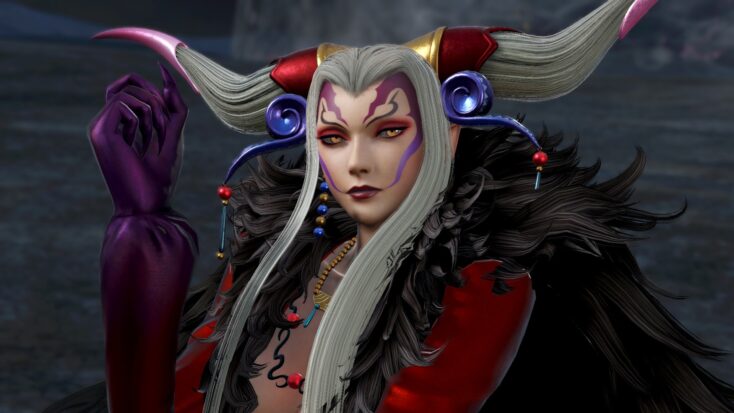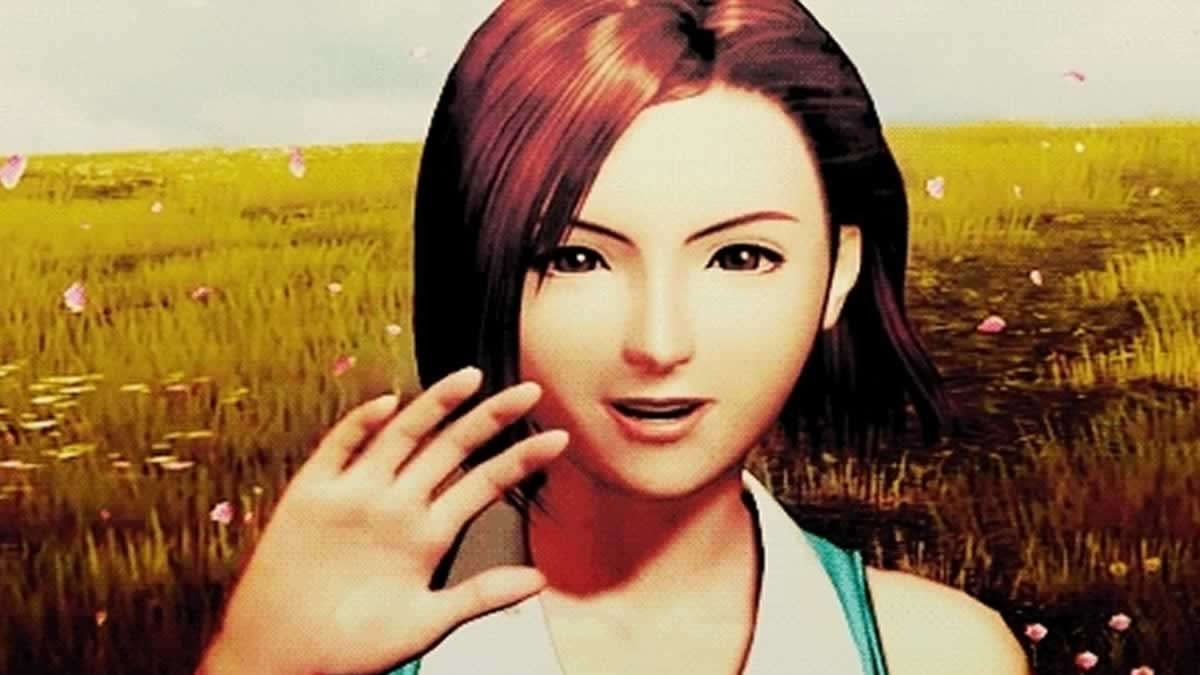
Squall is Extradimensional

This column is a reprint from Unwinnable Monthly #166. If you like what you see, grab the magazine for less than ten dollars, or subscribe and get all future magazines for half price.
———
Analyzing the digital and analog feedback loop.
———
So…I may be trapped in the faerie realm. While I’m here indefinitely I will take advantage of the strange time loop I’m caught in and talk about a moment that dovetails somewhat with my last dispatch.
There’s a moment that encapsulates the same uncanny feeling Déraciné is suffused with – of being felt but not perceived – in Final Fantasy VIII (hereafter FFVIII). While it’s not necessarily the most straightforward of its series, FFVIII’s narrative involves a possible time loop and time travel (don’t get me started on the Squall is Dead and Rinoa is Ultimecia theories). Throughout the gameplay you switch perspectives and time periods with Laguna Loire, a playable protagonist who has a sort of psychic connection with the main player character Squall. At first Squall and his chosen party members during these sequences are merely observers. But eventually Laguna starts to notice he has a heightened sense of his environment and is more successful in combat whenever Squall and co. are present.
In other more meta terms, Laguna is somewhat aware that the game has switched perspectives from Squall to his. He refers more than once to the player’s unseen presence as faeries. This is a strong game memory for me precisely because it communicated the idea of the player as an unseen but felt presence giving input so strongly. In Déraciné, the way this concept is communicated is via the way that the fae can directly affect time and space, freezing each scene into a tableau vivant before interacting with people or their possessions (both physical and metaphysical). As for FFVIII, it shares with Déraciné the incorporeality of a fae presence, as Laguna is only aware of the SeeD trainees presence through a deep sense of intuition.
When he finally meets with Squall and his party in-person late in the game he describes the experience as, “it was like there were some kind of waves running through my head. They gave us so much power during battle. We thought they were some kind of faeries flying over us.” As the quote suggests, there does seem to be a similar awareness shared by Laguna’s fellow soldiers and friends Kiros and Ward. The reason there’s a connection between Laguna’s mind and Squall’s is explained albeit vaguely via Ellone, an orphan like Squall who is revealed to be his older step-sister and a powerful sorceress.
Ellone has the ability to send people’s consciousnesses to the past or the future. She can also link with people’s consciousnesses telepathically, a process she calls (in a rather charming Y2K era fashion) “connecting” and “disconnecting”. When she’s connected with a person’s consciousness more than once she can also send a person’s consciousness into someone else’s mind. No matter where or when they are. The person who receives that consciousness will not be fully cognizant of that presence, but as mentioned above, will intuitively know someone or something is there.

What this makes me think of is how people often characterize new technologies of connection in miraculous terms. Especially technologies that facilitate social connection across time and space. The telegram, the phone, dial-up and wireless internet, etc. All of these technologies feel both intuitive and mystical. Intuitive in that humans love to find ever more ways to connect with one another near and far, mystical in that humans are pattern- and meaning-making creatures and that which is unseen yet acts upon us anyway feels powerful. Sometimes even ominous.
Brooklyn writer and artist Ingrid Burrington’s work, like Networks of New York: An Illustrated Field Guide to Urban Internet Infrastructure, often critiques this notion of technology being ethereal and difficult to comprehend. She does this by explicitly mapping out the physical networks of the internet in her area and educating locals on how to make their own maps and read their environment to gain greater internet literacy and knowledge. Burrington also likes to physically represent the marketing jargon of the internet age in her art, like “the cloud”, which often paints the internet and its processes with a thick coat of obscurity, presenting it as ephemeral and esoteric.
This language and its attendant imagery are deliberate of course, Burrington asserts, meant to keep laypeople at the mercy of the experts at the corporations that provide us with our essential everyday technology. In short, hiding the processes of the internet is about gatekeeping. And such gatekeeping is connected to a long-standing history of colonial narratives about who gets to be in control of land and resources and who is privileged enough to have a more embodied connection to technology and computation.

There’s a concept important to EcoGothic literature that is related to the above power dynamics FFVIII and (tangentially) Burrington explore. Telesthesia. The term at its most simplistic refers to extrasensory perception, similar to a sixth sense in that it doesn’t discern information via any one traditional sensory organ, but different in one significant regard. According to Sharae Deckard, an associate professor in world literature at the University College Dublin in her overview of the EcoGothic genre in Twenty-First Century Gothic: An Edinburgh Companion, telesthesia is “the extension of perception beyond the normal range of the empirical senses to apprehend other situations in time and space. Telesthesia can telescope multiple temporalities, capturing the way in which different moments of socio-ecological crisis over long historical periods are over-layered on fractured environments” (emphases mine).
Deckard’s example of how telesthesia often occurs in EcoGothic media is Swamp Thing’s ability to perceive and communicate with “all the forms of life across the Louisiana wetlands” and signify his “radical alterity of non-human nature.” You might also associate telesthetic connection with how Will, Eleven and the beasties of Stranger Things’ Upside Down have a connection that is entangled with both the environment in the present, past and future (albeit a warped version of those temporalities). In fiction, a further example still could be the Gloom, a supernatural mycorrhizzal network that members of a colonial-imperialist family exploit for their own nefarious ends in Silvia Moreno-Garcia’s Mexican Gothic.
Telesthesia is a tricky thing to research the coining of because it’s rooted in occultism and parapsychology. From what I can gather, however, the term was first used by F.W.H. Meyers, a British psychical researcher who included it in his two-volume work Human Personality and Its Survival of Bodily Death. The definition from Human Personality’s glossary differs somewhat from Deckard’s EcoGothic take, but is essentially the same. Meyers’ telesthesia consists of “any direct sensation or perception of objects or conditions independently of the recognized channels of sense, and also under such circumstances that no known mind external to the percipient’s can be suggested as the source of the knowledge thus gained.”

While Ellone is not non-human, she is certainly more-than-human as a sorceress that can bend space and time to her will in a telesthetic way. And she isn’t the only such being either in the game. Antagonists Edea, Adel and Ultimecia are also associated with time magic, although Ellone’s powers of connection are unique and sought after by various forces in FFVIII’s world. Ultimecia, who wants to cast a spell known as Time Compression, which would effectively obliterate reality by allowing the sorceress to create a singularity of time and space in which only she exists and can recreate the universe according to her designs. But I’m getting off the rails a bit, so allow me to course correct.
What interests me about telesthesia and how it relates to Ellone, Laguna and Squall connecting psychically over time and space is that it’s a way for FFVIII’s writers to reckon with the strangeness of early internet era socialization. Even if subtextually, FFVIII tackles how abstracted socialization was starting to become in the early internet era where everyday life was becoming increasingly more mediated by technology.
Think about what the protagonists of this game do or experience due to the technological advancements of their world: as teenage licensed SeeD mercenary operatives, they must take theory and field exams constantly to determine their rank (which affects their salary level). Squall and Seifer are the epitome of hustle culture within the SeeD system, to the point that they scar each other in battle trying to prove who’s the best. Squall often feels dissociated from practically everyone and everything around him except his SeeD rank and missions. They are classmates who discover that they all came from the same orphanage which was overseen by Edea before she became the antagonist they fight against in the present. The time paradoxes that Squall is a part of makes his world and its social network literally much smaller throughout the game. The protagonists are able to travel to space in a spaceship that’s also a giant mecha and of course there’s the above discussion of being able to telepathically link minds across space and time.
People often criticize the vagueness or heavily coincidental nature of the plot in FFVIII, especially with regards to the origin story of the orphanage. But in addition to this harkening back to earlier entries in the Final Fantasy series that centered a story around a group of orphans, if we think about such coincidences within a framework of early internet networking, this plot point doesn’t seem as absurd. If anything, this coincidence seems to me a deliberate decision to highlight how strange the world is when it’s on the precipice of a new technological paradigm.

There’s a third concept of telesthesia that I’d like to end off with, because I think it best explains why the faerie-like presence of Squall’s connection to Laguna via Ellone still fascinates me. Mckenzie Wark, a media and culture studies professor at The New School and activist, posits that telesthesia has steadily become the way that people perceive and interact with the world. She describes telesthesia as a phenomenon made possible by technologies that connect us over long distances and “move information faster than the speed at which objects move” in physical space. Wark believes the capabilities of technologies like the telegram, telephone and smartphone and wireless internet to connect a mass amount of people and data has led social space to double or develop “a strange folded quality.” We’re living and interacting in our immediate physical environment but, simultaneously, we connect and interact with many minds in internet spaces we can access from practically everywhere in our physical environment.
When Ellone sends Squall’s mind back in time to connect with Laguna’s, it’s at once a mystical act and a quotidian one. Even in 1999 dial-up internet kids like me had an inkling they’d performed a similar ritual before, but on a lesser scale. And when I read that Laguna knew Squall and his allies were there but felt that they were like faeries hovering in the ether unseen, wasn’t that what early encounters on forums and instant chat services felt like? Like “some kind of waves running through” our heads, changing how we perceive our everyday lives. We are thoroughly disenchanted with the internet and social media now, but perhaps we could transform our relationship to these technologies if we commit to demystifying how they entranced us in the first place.
———
Phoenix Simms is a writer and indie narrative designer from Atlantic Canada. You can lure her out of hibernation during the winter with rare McKillip novels, Japanese stationery goods, and ornate cupcakes.




